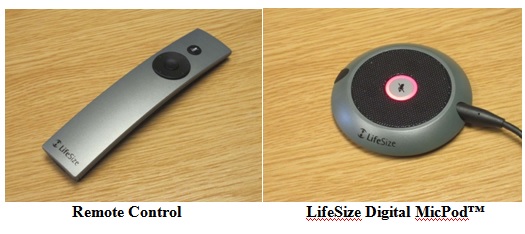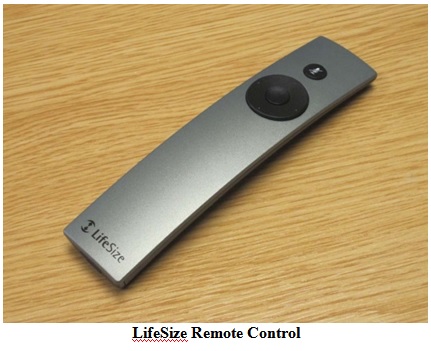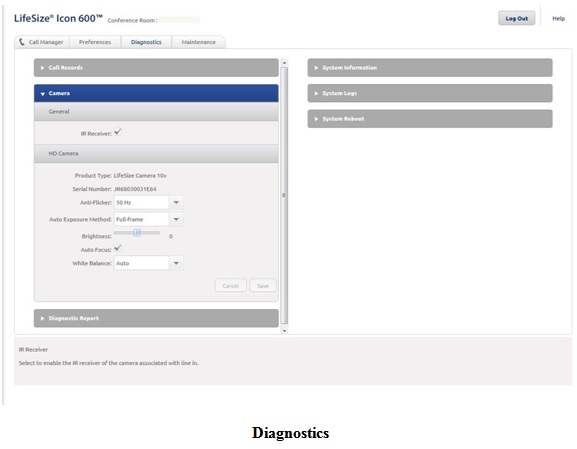Lifesize Icon 600 - Evaluation results main document
Manufacturer: LifeSize
Model: Icon 600™
Software Version: RM3_1.1.2
Optional Features and Modifications: 1080p
Dual Monitor
Date of Test: 29th April – 3rd May 2013
![]()


A: EXECUTIVE SUMMARY
The IP capable high definition Lifesize Icon 600™ conferencing system is designed to be installed either in a small to medium sized conference room or as part of a Rollabout system. It has adopted a new control philosophy with a simple remote control containing only navigation and microphone mute buttons. The navigation buttons drive an on screen graphic interface more commonly seen on consumer electronics as opposed to videoconferencing equipment.
The system includes a high definition (HD) Camera, microphone pod and infrared remote control.
The system is available with 2 camera and 2 microphone options:
-
CODEC, Camera 200, Digital MicPod™
-
CODEC, Camera 10x, Digital MicPod™
-
CODEC, Camera 200, LifeSize Phone™
-
CODEC, Camera 10x, LifeSize Phone™
The Camera 10x has a 10x zoom lens and is more sensitive in low light conditions than the Camera 200 with its 4x zoom.
Dual monitor and 1080p support are also both available as options. The systems supplied for evaluation included the 10x Camera and the LifeSize Digital MicPod™ desk microphone together with dual monitor and 1080p options.
The system is capable of conferencing up to a maximum picture resolution of 1920x1080 pixels (1080p) at 60fps with a maximum connection speed of 6 Mbit/s. Compatibility with other H.323 CODECS is achieved across a range of resolutions from CIF (352x288) to 1920x1080 pixels, the quality of the conference being dependent upon the capability of the remote CODEC and the connection speed.
Pros:
-
Simple remote control with graphic user interface
-
Excellent audio performance
-
Video quality including 1080p 30fps on the Presentation Channel
-
Good compatibility with other CODECS
Cons:
-
Restricted image layout options
-
Digital presentation image stretched if 4*3 aspect ratio.
Feature Summary:
|
Video standards |
H.263+ and H.264 |
|
Supported video resolutions, 200 including: |
QSIF (176x120) 1080p (1920x1080) at 60fps |
|
Communications |
H.323 128Kbps - 6Mbps |
|
Audio standards |
G.711, G.722, G.722.1, G.722.1C, and MPEG4 AAC-LC 16KHz audio coding |
|
Camera |
4x or 10x Optical zoom camera, PTZ function, 1080p native resolution, 10 camera presents, far end camera control |
|
Video inputs |
PTZ Camera input (1080p), VGA/DVI Input |
|
Video outputs |
Optional dual monitor support HDMI output, VGA/DVI video output, |
|
Audio inputs |
Lifesize Link Digital MicPod™, stereo mic/line, HDMI audio, DVI-I audio |
|
Audio outputs |
HDMI audio, 3.5mm mini jack audio |
|
VC Auxiliary features |
H.239 second video channel up to 1080p resolution @30fps. |
|
Encryption |
AES Encryption |
B: SETUP PROCEDURE
The camera (positioned adjacent to a picture monitor) and the CODEC have their own power supplies and together with the LifeSize Digital MicPod™ and infrared remote complete the package. Cabling the system was easy and involved:
-
Connecting the supplied HDMI-HDMI and DVI-DVI leads between the CODEC and the high definition monitors.
-
Connecting the HDMI cable between the CODEC and the camera.
-
Connecting the mini USB cable between the Digital MicPod™ and the CODEC.
-
Establishing an Ethernet IP network connection through the single RJ45-RJ45 cable.
-
Connecting power to the CODEC and camera from their external power supplies.
-
System set up was conveniently configured through the web browser interface once the network had configured via DHCP; very limited system setup menus are available via the remote control.
Approximate set-up time: 20 Minutes
Documentation quality: The documentation was concise and easy to follow and included: a printed Quick Reference card, with user manual and software release notes available on the Lifesize website.
The entire set up procedure was straightforward.
C: Hardware Description
General
The compact CODEC may be cabinet mounted horizontally under a picture monitor, it cannot be rack mounted. The system is an IP only unit with a single 10/100/1000 Mbit/s, auto switching, Ethernet connection, enabling single site connection speeds of up to 6 Mbit/s. The Ethernet port may be manually configured or set to auto negotiate.
During the evaluation, on a system reboot with the network cable connected, the network does not connect. Warning messages “Communication Signalling Service – Not Ready” and “Communication Media Service – Initiating” are displayed. The network cable must be disconnected prior to reboot and only reconnected once the system is operational for the network to successfully connect.
The system interoperates with the Lifesize UVC Platform to provide Multisite and Recording/Streaming facilities. Lifesize UVC Manager may be used to control and configure the Icon 600™ series codec remotely. These services were not tested during the evaluation.
The CODEC supports over 200 video resolutions including:
-
The basic CIF format resolution of 352x288 pixels
-
wCIF at 400x244
-
w288p at 512x288
-
w432p at 768x432
-
w480p at 848x480
-
High definition (HD) w720p, 1280x720
-
High definition (HD) w1080p, 1920x1080
The following monitor display resolutions and maximum frame rates are supported:
-
1280 x 720p 60fps
-
1920 x 1080p 60fps
CODEC display resolution set to 1080p
|
Connection Bandwidth |
Resolution |
Frame rate |
Audio |
|
128 Kbit/s |
576 x 320 |
20 |
G722.1 C |
|
384 Kbit/s |
928 x 528 |
30 |
G722.1 C |
|
768 Kbit/s |
1280 x 720 |
30 |
MPEG4 AAC-LC |
|
1 Mbit/s |
1232x 688 |
60 |
MPEG4 AAC-LC |
|
2 Mbit/s |
1920x1080 |
60 |
MPEG4 AAC-LC |
|
3 Mbit/s |
1920x1080 |
60 |
MPEG4 AAC-LC |
|
4 Mbit/s |
1920x1080 |
60 |
MPEG4 AAC-LC |
|
6 Mbit/s |
1920x1080 |
60 |
MPEG4 AAC-LC |
Auto sensing single and dual picture monitors are supported together with HDMI and DVI-I high definition outputs.
The HDMI connection includes the main default audio output signal but additional analogue audio outputs are also provided.
The main video output includes on-screen menus navigated by the simple direction and enter buttons on the remote control.
![]()
Picture in Picture (PIP) is provided which allows both near and far end images to be displayed simultaneously on a single picture monitor. The PiP will default to 'off' on an incoming call and the control to turn it on is in the admin settings menu which some users may find difficult to locate. Full screen “Self View” is not available when in a call.
![]()
![]()
In single monitor mode with the main camera being transmitted the only image control is Picture in Picture (PIP) which may be set to be On or Off, the default is Off on call connection:
-
Full screen far end image + PIP of near end image
-
Full screen far end image
When an H.329 presentation image together with the main camera image are either transmitted or received, six screen display layout options are available, three with PiP Off and three with PiP On :
-
Presentation image full screen
-
Far end image full screen
-
Presentation and far end images side by side POP
-
Presentation image full screen plus near end image as PIP
-
Far end image full screen plus near end image as PIP
-
Presentation and far end images side by side POP plus near end image as a PIP
![]()
![]()
In dual monitor mode the following images are displayed on each monitor:
|
Main Monitor |
Second Monitor |
|
|
Not in a call |
Near image + menu |
Black |
|
In a call with no presentation material |
Far image + menu With or without Near image PiP |
Far Image |
|
In a call with presentation material transmitted or received |
1. Far image + Presentation image side by side 2. Presentation image full screen 3. Far image full screen With or without Near image PiP |
Presentation image |
The LifeSize 10x HD camera features pan, tilt and zoom functions with a wide horizontal viewing angle of 70 degrees and connects to the CODEC through the standard 3 metre HDMI cable. As an option this cable may be extended up to a maximum of 10 metres. Ten camera pre-set positions together with Far End Camera Control (FECC) may be recalled from the remote control.
The camera menu includes a range of manual settings for exposure, white balance and anti-flicker. It was noted that when anti-flicker was set to 50Hz a distortion was viewed at the bottom of the video image displayed on the second monitor output.
The 10x camera produced good results at lower lighting levels. The operation of the camera Pan and Zoom controls does generate some mechanical noise and the CODECs vari-speed cooling fan also generates noise but is noticeably quieter that other Lifesize products tested in the past. The auto focus responded quickly and effectively. The CODEC supports remote camera control.
A PC may be interfaced directly via the DVI-I/VGA connector on the rear of the CODEC. Although no supported resolutions are specified in the Data Sheet, we observed successful connections at the following EDID recommended resolutions:
|
VGA |
DVI-I |
|
800 x 600 |
800 x 600 |
|
1280 x 720 |
1280 x 720 |
|
1600 x 900 |
1600 x 900 |
|
1920 x 1080 |
1920 x 1080 |
During an H.323 call a second unidirectional video channel (dual stream) is provided through the H.239 protocol. Thus video from the camera and a PC could be transmitted simultaneously. The bandwidth split between main and H.239 channels may be adjusted by the user with 10 to 50% of the overall bandwidth allocated to the H.239 channel.
When a 4 x 3 aspect ratio video image is transmitted from a computer the displayed aspect ratio is different for analogue and digital signals. Analogue signals retain their native 4x3 aspect ratio whereas digital signals are stretched to 16x9 and therefore the aspect ratio is distorted.
Several audio formats are supported by the LifeSize Icon 600™ system, including the ITU standard MPEG-4 AAC-LC, providing 16KHz analogue audio. The audio quality during the evaluation was excellent.
The Digital MicPod™ microphone includes a mute button; this button illuminates blue when in a call and red when the microphone is muted. In larger locations two MicPods may be connected by using a daisy chain cable. Alternatively the LifeSize 2nd Generation Phone™ provides the conference microphone together with a fully featured SIP conference telephone. To provide system control, the LifeSize phone includes a touch screen control panel.

A mini jack connector facilitates straightforward integration with external microphones at mic level or a microphone mixer at line level. When the Digital MicPod™ is connected this analogue input is overridden hence there is no apparent option to transmit audio from a laptop during a presentation. However it is possible using an SSH Telnet command to enable the analogue audio input for use with laptop audio, in this configuration the audio is only transmitted to the remote site and heard locally when the presentation source is selected. The Mic Mute button also inhibits this input. This workaround is not documented in the User Guide.
A Kensington lock is provided on the rear of the CODEC for added security.
D: SYSTEM OPERATION
The Icon 600™ system adopts a new control philosophy with a simple remote control containing only navigation and microphone mute buttons. The navigation buttons drive an on screen graphic interface of the style more commonly seen on consumer electronics as opposed to videoconferencing equipment. This interface was intuitive and easy to operate. There are very few administrative settings available on screen but these are available via a web browser or via the UVC Manager software - a license which is supplied with the Icon 600™ system.
The system also supports calendar integration, meeting schedule directory and reminders via UVC Manager.

![]()
An H.239 connection is initiated by selecting “Presentation” through the remote control and the on-screen graphical interface, the system will also auto-start on laptop connection. The main camera normally occupies one channel and another selected image source the second channel. The remote site then receives separate images for display on two monitors.
![]()
The operation of the interface is, in general, intuitive, however the PiP may only be set to On or Off and defaults to Off when a call connects. The PiP control is in the Advanced Settings menu which some users may find difficult to locate. When in a call it is not possible to display Selfview full screen. In addition there are a limited number of available layouts when presentation material is shared: in single monitor mode for example it is not possible to display the Presentation Full Screen and the far end image in a PiP.
-
Presentation image full screen
-
Far end image full screen
-
Presentation and far end images side by side POP
-
Presentation image full screen plus near end image as PIP
-
Far end image full screen plus near end image as PIP
-
Presentation and far end images side by side POP plus near end image as a PIP
The system takes one minute forty seconds to boot up from cold. When not in a call the system automatically reverts to sleep mode after 10 minutes of inactivity, it may also be put into sleep mode from the graphic interface. An incoming call or pressing a remote control button will return the system to active mode.
The Caller Information menu displays comprehensive statistics including call status data: resolution, connection speed, compression protocols, packet loss and frame rate for the main video channel, presentation channel and audio. The CODEC did however report a network connection speed of 10Mbit/s Half Duplex while the Web Browser reported 100 Mbit/s Full Duplex, the image quality suggested full duplex had been negotiated.
A comprehensive web browser interface provides control and configuration of the system, Web snapshots of images at the CODEC are not available.




E: VIDEO TESTS SUMMARY
The overall video quality of conference images was excellent. The ability to transmit 1080p 30fps on the presentation channel was impressive, however, with the maximum 3Mbit/s bandwidth allocated to the presentation channel, 720p 30fps produced better results on fast moving image material with less image blocking.
F: AUDIO TESTS SUMMARY
Setup The echo canceller is fully automatic in operation. The quality of echo cancellation and doubletalk was excellent.
|
Lecture Theatre |
Room |
|
|
Audio levels adequate? (Yes/No) |
Not tested |
Y |
|
Audio quality acceptable? (Yes/No) |
Not tested |
Y |
|
Echo cancellation acceptable? (Yes/No) |
Not tested |
Y |
|
Quality of double talk |
Not tested |
Excellent |
G: DATA TESTS
A PC may be directly connected to the CODEC via the DVI-I/ VGA interface.
H: CONNECTIVITY
Connectivity between Like Machines
H.323
There were no problems connecting between the LifeSize Icon 600™ units.
During an H.323 call the network connection was removed and reconnected after a specific time.
|
5 Seconds |
Picture froze - successful reconnection, call does not terminate |
|
15 Seconds |
Picture froze - successful reconnection, call then terminates after 3-4 secondss seconds |
Time to Connect
|
H.323 |
3 Seconds |
Connectivity with Other Machines (models listed with comments)
H.323
Successful connections were made in each direction with the following CODECs at the maximum bandwidth possible, where the system supported H.239 presentation material was also shared.
|
CODEC |
Call Bandwidth |
Resolution Transmitted by the Icon 600™ |
Resolution Received by the Icon 600™ |
|---|---|---|---|
|
Polycom HDX 9002 S/W 2.6.0 |
2 Mbit/s |
w720p @ 30 |
w720p @ 25 |
|
Tandberg 6000 MXP* S/W F9.0 PAL |
4 Mbit/s |
720 x 400 @ 30 |
w720p @ 30 |
|
Cisco SX20 S/W TC5.1.4 |
6 Mbit/s |
w1080p @ 60 |
w720p @ 60 |
|
Cisco C40 (MLVC) S/W TC5.1.1 (No Premium Res) |
6 Mbit/s |
w720p @ 30 |
w720p @ 30 |
|
Cisco C60 (Prem Res) S/W TC4.2.1 |
6 Mbit/s |
w1080p @ 30 |
w720p @ 60 |
|
Cisco C90 (Prem Res) S/W TC4.2.1 |
6 Mbit/s |
w1080p @ 30 |
w1080p @ 30 |
|
Lifesize Express 220 S/W 4.9.00 |
4 Mbit/s |
w720p @ 60 |
w720p @ 30 |
|
Lifesize Team S/W 4.7.19 |
4 Mbit/s |
w720p @ 30 |
w720p @ 30 |
|
Lifesize Room 200 S/W 4.7.10 |
6 Mbit/s |
w720p @ 60 |
w720p @ 30 |
*In calls to the Tandberg 6000MXP H.239 presentation material could not be transmitted from the Tandberg to the Icon 600™
Connectivity with Janet Videoconferencing Service
H.323
The Lifesize Icon 600™ connected successfully to the Janet Codian MCU at high definition using H.264 video, 720p resolution and AAC-LC audio with video and audio in both directions.
H.239 also interoperated correctly. The received audio level was measured as peaking to -7dBm.
Procedure for making a call
-
Select Call on the graphic interface
-
Select Dialer
-
Input IP address or E.164 number
-
Press Call on the graphic interface. Or use the contacts directory, recent calls list or favourites available from the user interface.





